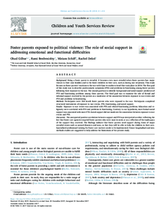Displaying 1411 - 1420 of 2214
This learning brief analyzes quantitative data from the second of the “Deinstitutionalization of Orphans and Vulnerable Children in Uganda” (DOVCU) project’s stated objectives: examining the extent to which DOVCU project interventions decrease vulnerabilities for reintegrating children and their families.
The aim of this special issue of the International Journal of Longitudinal and Life Course Studies is to examine the outcomes of children who were raised for part of their childhood in out-of-home care, including in foster care and institutions.
This policy essay from the Journal of Family Strengths explores the overrepresentation of LGBTQ youth in the US child welfare system and how to foster greater acceptance, inclusion, and trauma-informed care for these children.
This research collected rare and vital primary data by interviewing practitioners within looked-after children’s, residential, and respite services. The study established that practitioners lacked basic awareness of radicalisation and extremism, the Prevent strategy, and the Channel programme.
For many social workers, participatory practice may seem an unachievable goal, particularly in the field of child protection. This paper discusses a significant programme of change in one London local authority, as part of which the authors undertook 110 observations of practice and provided more than eighty follow-up coaching sessions for workers.
The first goal of this study was to describe posttraumatic symptoms (PTS) and problems in functioning among foster parents following their exposure to the war.
This study examines and compares the extent of child maltreatment (physical, emotional, and sexual abuse; physical and emotional neglect) and lifetime traumatization with regard to current adult mental health in a group of survivors of institutional abuse and a comparison group from the community.
The purpose of this mixed methods study was to assess the experiences of child welfare workers trained in Family Finding and to assess the experiences of the youth who participated in Family Finding.
This report continues a predecessor Committee’s inquiry into fostering in the UK. It emphasizes the importance of valuing the young people in foster care, foster carers, and the foster care system itself.
The Education Committee of the UK's Parliament has published a report on Foster Care. The report includes conclusions and recommendations for valuing young people in care as well as foster carers and the care system.





